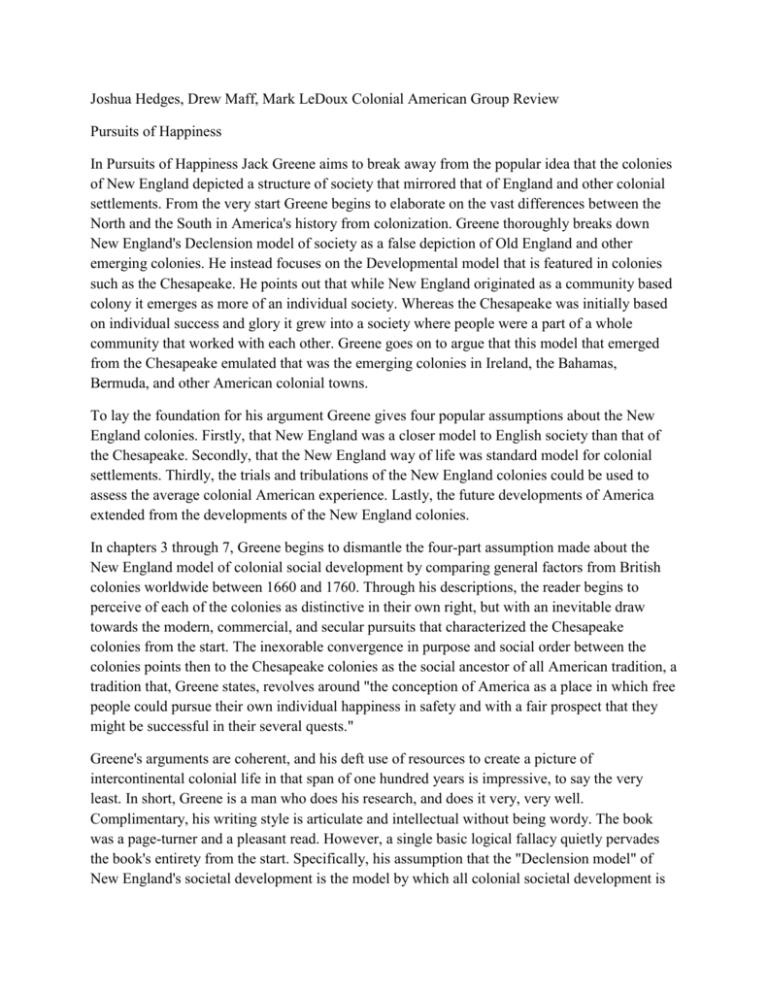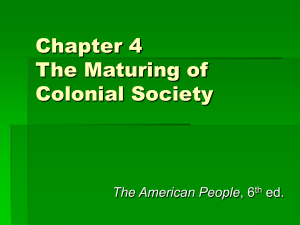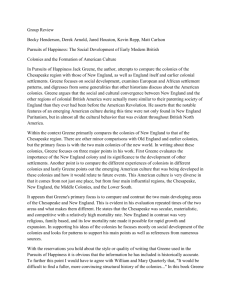Greene - Pursuits of Happiness group J
advertisement

Joshua Hedges, Drew Maff, Mark LeDoux Colonial American Group Review Pursuits of Happiness In Pursuits of Happiness Jack Greene aims to break away from the popular idea that the colonies of New England depicted a structure of society that mirrored that of England and other colonial settlements. From the very start Greene begins to elaborate on the vast differences between the North and the South in America's history from colonization. Greene thoroughly breaks down New England's Declension model of society as a false depiction of Old England and other emerging colonies. He instead focuses on the Developmental model that is featured in colonies such as the Chesapeake. He points out that while New England originated as a community based colony it emerges as more of an individual society. Whereas the Chesapeake was initially based on individual success and glory it grew into a society where people were a part of a whole community that worked with each other. Greene goes on to argue that this model that emerged from the Chesapeake emulated that was the emerging colonies in Ireland, the Bahamas, Bermuda, and other American colonial towns. To lay the foundation for his argument Greene gives four popular assumptions about the New England colonies. Firstly, that New England was a closer model to English society than that of the Chesapeake. Secondly, that the New England way of life was standard model for colonial settlements. Thirdly, the trials and tribulations of the New England colonies could be used to assess the average colonial American experience. Lastly, the future developments of America extended from the developments of the New England colonies. In chapters 3 through 7, Greene begins to dismantle the four-part assumption made about the New England model of colonial social development by comparing general factors from British colonies worldwide between 1660 and 1760. Through his descriptions, the reader begins to perceive of each of the colonies as distinctive in their own right, but with an inevitable draw towards the modern, commercial, and secular pursuits that characterized the Chesapeake colonies from the start. The inexorable convergence in purpose and social order between the colonies points then to the Chesapeake colonies as the social ancestor of all American tradition, a tradition that, Greene states, revolves around "the conception of America as a place in which free people could pursue their own individual happiness in safety and with a fair prospect that they might be successful in their several quests." Greene's arguments are coherent, and his deft use of resources to create a picture of intercontinental colonial life in that span of one hundred years is impressive, to say the very least. In short, Greene is a man who does his research, and does it very, very well. Complimentary, his writing style is articulate and intellectual without being wordy. The book was a page-turner and a pleasant read. However, a single basic logical fallacy quietly pervades the book's entirety from the start. Specifically, his assumption that the "Declension model" of New England's societal development is the model by which all colonial societal development is viewed and recorded by historians. This is key, as it is the very thing he is trying to disprove, but the reader has no sense that his initial assumption is correct in the first place: Greene does not adequately demonstrate that this model is predominant in American colonial historiography. The result is that his argument becomes a sort of straw-man; he sets up the very argument he plans to dismantle, making his thesis a success from the start. This could be seen by the third chapter, and left his other arguments somewhat disappointing for a man so apparently knowledgable. The end of the book tells how the colonies played an important part in the development of American society up to the Revolutionary War. One of these developments was creating metropolitan cities in most of the regions that were occupied by British Colonies. Besides the thriving cities the lasting colonies had flourishing economies with exploding populations. Without this strong base, the Revolutionary War might have not occurred. The book has a reoccurring theme on the importance of having a strong economy and without it colonies would not survive. The book is a great overview of the history and development of British colonies in the New World. It was surprising that Greene was able to incorporate effectively the different cultures from one colony to another. Before reading the book, it appears to the average student of history that the colonies were much more similar then they really were. After reading it would make sense that the colonies were different because of weather in the area and political opposition. A colony in Georgia would have different issues compared to colonies in New York especially when making treaties with the natives. The third plus is that the book builds up to the Revolutionary War and each chapter layers on top of the previous one. The complication in the book is that it doesn't give many details for specific colonies except for the Chesapeake and New England colonies. Greene introduces a lot of information and if somebody has an interest he or she will have to research further. Another negative was the lack of discussion of Native Americans and their effect on trade which is hardly mentioned throughout the book. The colonies had to be extremely diplomatic when dealing with the Native Americans. When the colonies were originally formed the natives outnumbered the European settlers and would continue to have a strong hold in areas like the Ohio Valley until after the Seven- Year-War between France and England. Even with these couple of complaints the book was informative and I would suggest it to anyone looking for reading on the colonies.










